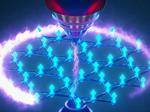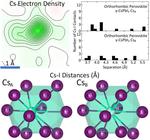Other
News Super surfaces use terahertz waves to help bounce wireless communication into the next generation

“Assembling tiny chips into unique programmable surfaces, Princeton researchers have created a key component toward unlocking a communications band that promises to dramatically increase the amount of data wireless systems can transmit. The programmable surface, called a metasurface, allows engineers …

“Princeton researchers have confirmed a theory first put forward in 1929 by the Nobel laureate Felix Bloch, who theorized that certain kinds of materials, when drawn down to a very low electron density, would spontaneously magnetize. In the study, published …

“Light-emitting diodes, or LEDs, are nearly ubiquitous in modern life, providing the brightness in phone displays, televisions, and lights. A new form of LEDs, made of a class of materials called halide perovskites, promises higher color quality and ease of …

“An international team led by researchers at Princeton University has uncovered a new class of magnet that exhibits novel quantum effects that extend to room temperature. The researchers discovered a quantized topological phase in a pristine magnet. Their findings provide …

“Researchers in the Cava Group have demystified the reasons for instability in an inorganic perovskite that has attracted wide attention for its potential in creating highly efficient solar cells. Using single crystal X-ray diffraction performed at Princeton University and X-ray …

“Computers are renowned for flexibility, running everything from game consoles to stock exchanges. But at the level of computation, most computers rely on arrays of identical processors called cores. Now, a team at Princeton University has built a hardware platform …

“A discovery that long eluded physicists has been detected in a laboratory at Princeton. A team of physicists detected superconducting currents — the flow of electrons without wasting energy — along the exterior edge of a superconducting material. The finding was published …

“Hidden beneath our everyday world — on the infinitesimal scale of atomic and subatomic particles — is a strange and elusive realm. It is a Lewis Carroll-like place where ghostly particles pop in and out of existence, swirling electrons occupy two positions …

“Imagine a world where people could only talk to their next-door neighbor, and messages must be passed house to house to reach far destinations. Until now, this has been the situation for the bits of hardware that make up a …
“A Princeton University research team has shown that silicon quantum bits (qubits), mediated by a microwave photon, can interact even when spaced relatively far apart on a computer chip. The ability to transmit messages across relatively long distances on a …
